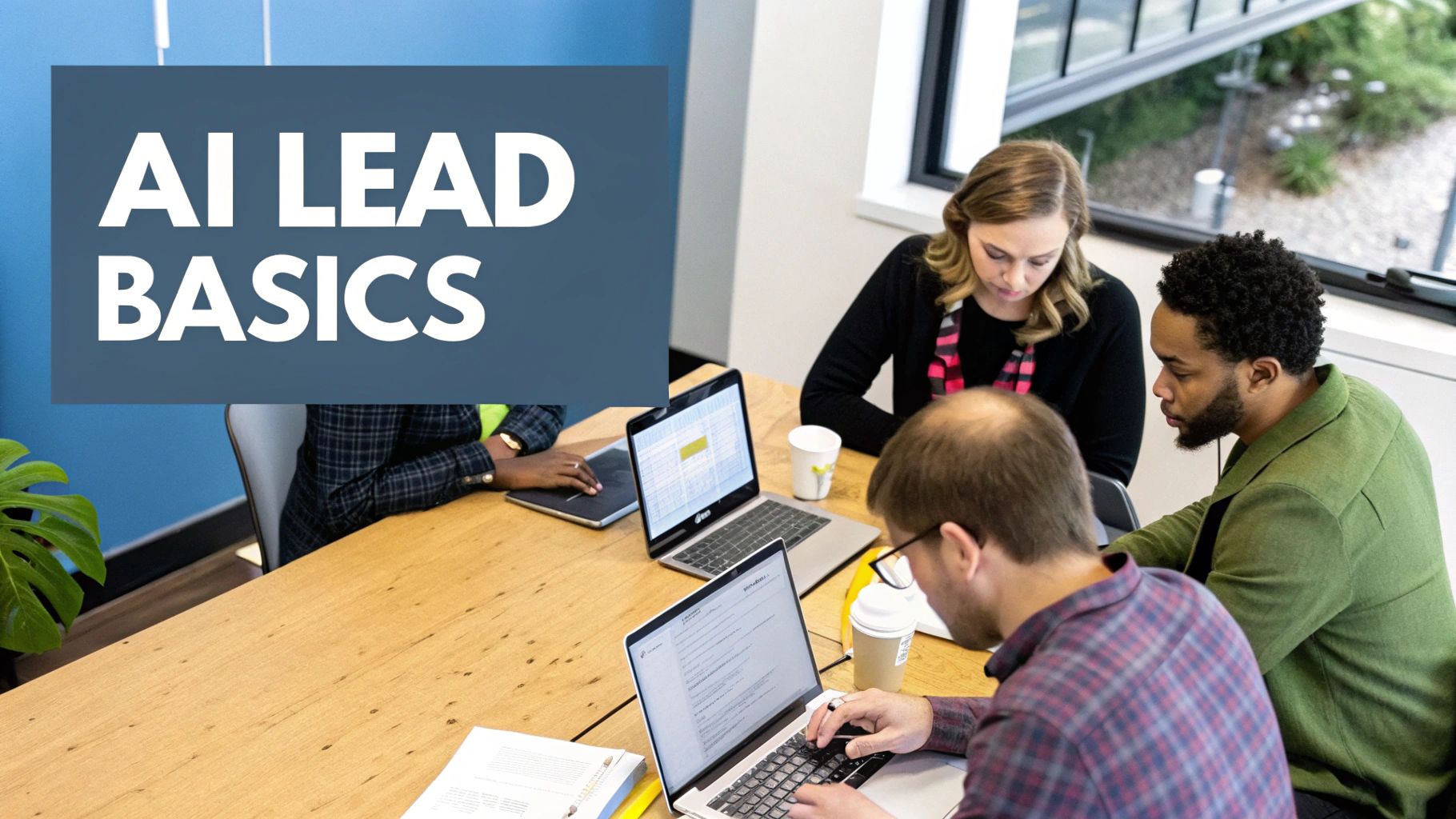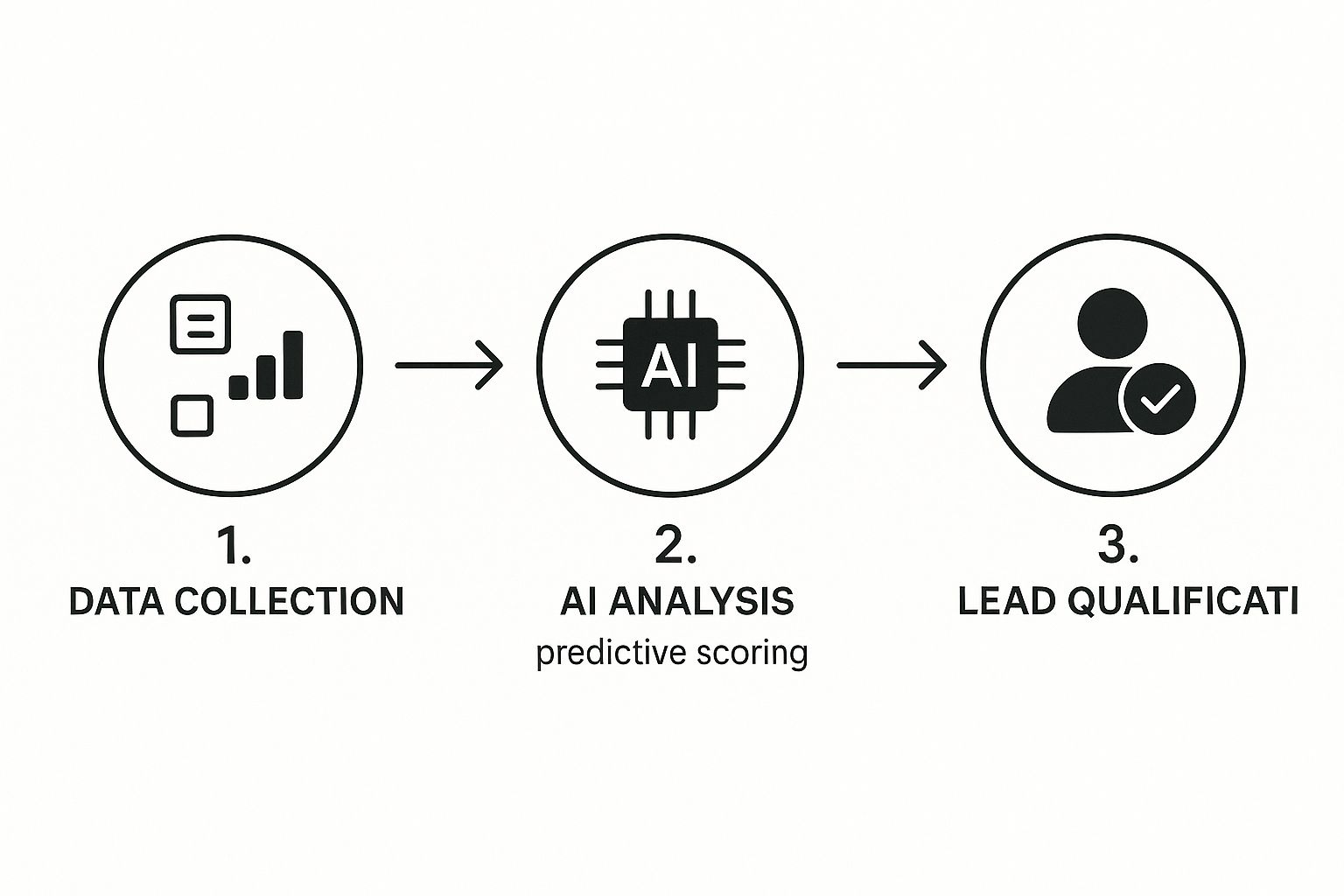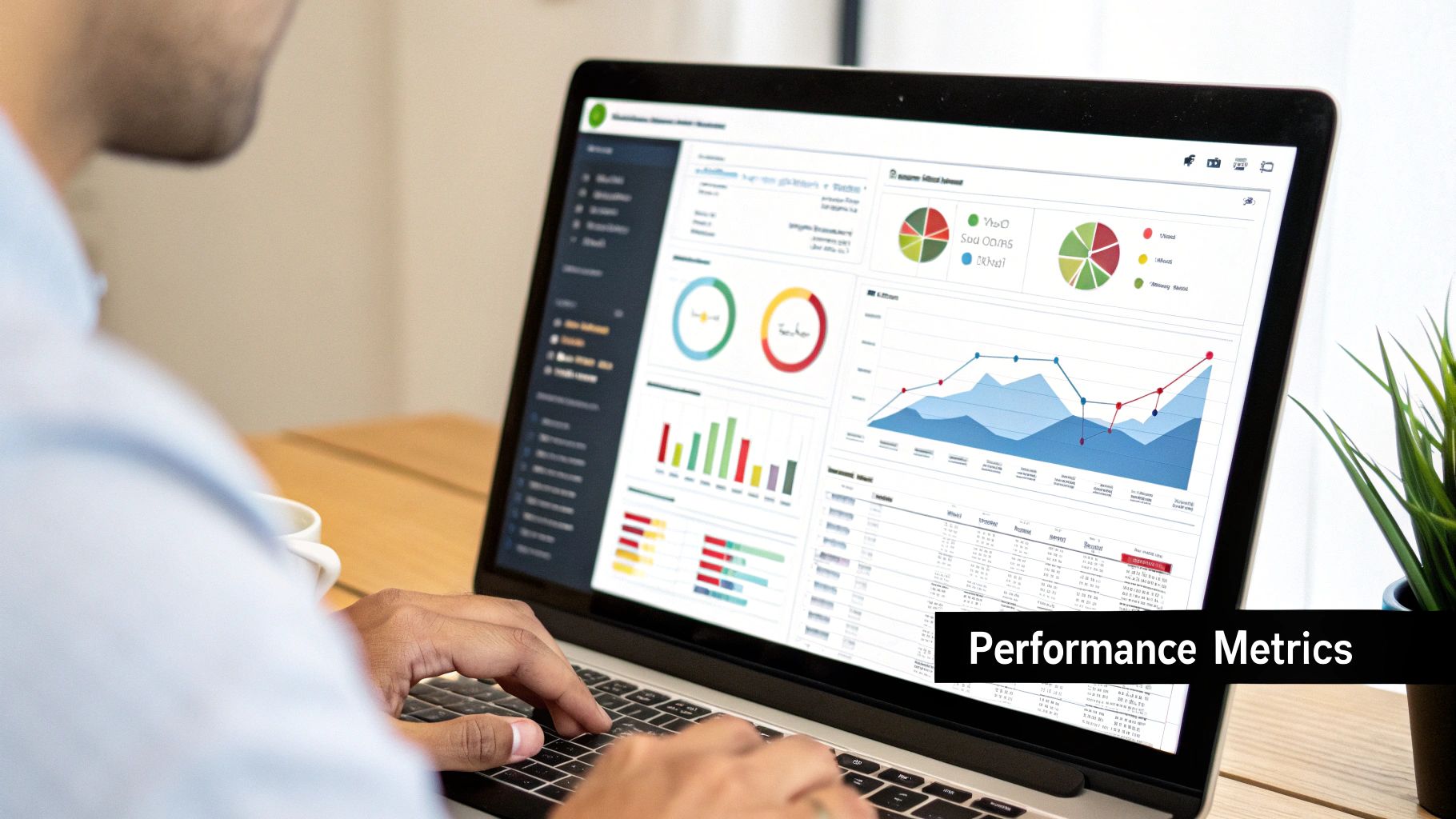When we talk about using AI for lead generation, we're really talking about putting automated intelligence to work finding, qualifying, and engaging potential customers far more efficiently than a human team ever could. It’s about handing off the repetitive tasks, analyzing data to figure out which leads are actually worth pursuing, and personalizing your outreach on a massive scale.

Let's cut through the noise. Artificial intelligence isn't some far-off concept just for giant corporations with bottomless budgets anymore. Today, there are genuinely accessible AI platforms that empower small and medium-sized businesses to completely rethink how they find new customers.
The core idea is refreshingly simple: let AI handle the tedious work, uncover deep insights about potential clients, and personalize communication in ways that used to require a huge team.
By 2025, AI-driven lead generation has become a true game-changer for optimizing the entire sales funnel. Businesses now lean on AI's data-driven insights to automate lead qualification, sifting through massive datasets to understand buyer behavior and prioritize who to contact first. This shift dramatically cuts down on the manual grind for sales teams.
This evolution isn't just about saving time; it's about making smarter, more strategic decisions. You can explore plenty of proven strategies for automating lead generation to see just how these concepts are being applied across different industries.
So, what does this look like in the real world? It all boils down to a few key strategies that work in tandem, creating a powerful system that hums along in the background. Think of it as the engine for your lead generation machine.
The real magic of AI is its ability to handle all that top-of-funnel grunt work. This frees up your team to do what they do best: build relationships and close deals. It's a true efficiency multiplier.
For agencies, getting a handle on this shift is absolutely critical. We've put together a detailed guide on the role of artificial intelligence in revolutionizing marketing agency services that you might find useful.
To give you a clearer picture, let's break down how these AI strategies directly solve common business challenges.
Each of these pieces plays a vital role in building a modern, automated lead generation system.
The rest of this guide will walk you through the practical, step-by-step methods to make these strategies a reality for your business. We're getting into the nuts and bolts now.
Alright, let's move from the 'what' to the 'how.' This is where you actually see AI start working for your business, turning abstract ideas into a real system that captures leads without you lifting a finger. We’re talking about building an automated lead capture engine—a smart combination of AI tools that gathers, filters, and routes new leads from all over the web.
Think of it as casting a digital net that’s working for you 24/7. A great example is an AI receptionist. For a local plumbing company, this means catching an emergency call at 2 a.m. That call would have otherwise been a missed opportunity, but now it's a scheduled, high-value job.
This diagram shows how data can flow from that first touchpoint all the way to a qualified sales opportunity.

The real magic here is that AI acts as an intelligent filter. It makes sure only the most promising leads—the ones scored and analyzed for genuine interest—get passed along to your sales team.
Your website and social media profiles are the front doors for new leads, so let's start there. One of the most effective tools you can add is an AI-powered chatbot. It’s so much more than a static contact form; a chatbot engages visitors in a real-time conversation, asks key qualifying questions, and can even book appointments right into your calendar.
Another smart tactic is using AI social listening tools. These platforms scan social media for keywords and phrases that signal someone needs your services. Imagine someone posts on X asking for recommendations for a "good local accountant." Your AI can flag this as a hot lead, letting you jump into the conversation right away.
A critical part of building an automated lead capture engine is using effective lead magnet ideas to pull prospects in. AI can then help personalize which lead magnet someone sees based on how they're behaving on your site.
The whole point is to create multiple, automated entry points into your sales funnel. Each one is staffed by an AI tool that works tirelessly to capture interest. You can get more ideas by checking out different lead generation automation strategies that show how to blend these tools for the best results.
To build a truly robust system, you'll want a few key components working in sync. Here are the foundational tools I always recommend starting with:
Picture this: a lead comes in through your website chatbot. That conversation is instantly pushed to your CRM, where another AI tool enriches the contact with company info and gives it a lead score. That seamless flow is the hallmark of a great automated engine, freeing up your team to focus on what they do best: closing deals.

Once leads start flowing into your funnel, the real work begins. You have to figure out which ones are genuine opportunities and which are just noise. For years, we’ve relied on basic signals—like an email open or a visit to the pricing page—to label leads as 'hot' or 'cold'. Honestly, it’s better than nothing, but it’s still mostly a guessing game.
This is where AI completely flips the script on lead qualification. It moves you from making educated guesses to making data-backed predictions.
Instead of just looking at one or two simple actions, AI-powered predictive lead scoring sifts through dozens of data points at once. It’s designed to spot complex patterns a person could never catch on their own.
The system pulls together a whole range of factors to weigh a lead's potential. Think about all the information it can analyze:
The AI then crunches all this data and assigns a simple numerical score to every lead, giving you a clear forecast of their likelihood to buy. This allows your sales team to instantly see who they should be talking to right now.
Let's say you run a B2B software company. Inside your CRM, you can set up AI-driven scoring rules that get to work the second a new lead comes in.
You could create rules that add points for positive signs, like:
And, just as important, you can subtract points for red flags:
The AI constantly updates these scores in the background. A lead might start with a low score but then shoot to the top of the priority list after they watch a product demo webinar. This dynamic process makes sure your sales team isn't wasting time on dead ends and is always focused on opportunities that can actually drive revenue.
Predictive lead scoring isn't just about being faster; it's about being smarter. By letting a machine find the hidden patterns, you get rid of the guesswork and help your team engage the right person at the perfect moment.
This is a massive leap forward for sales efficiency. Research has shown that companies putting AI to work have seen revenue jump by 3% to 15%, along with a 10% to 20% bump in sales ROI.
Giving your team the ability to automatically surface the best prospects is one of the most practical applications of AI in business today. To dive deeper into the setup process, check out our guide to boost sales with AI lead qualification. It's all about helping your team stop chasing leads and start closing deals.

Let's be honest: generic outreach is dead. If your emails still start with "Dear Sir or Madam" or you're blasting the same message to hundreds of people, you’re not just being ignored—you're actively hurting your brand. Today's customers expect communication that actually speaks to them, their business, and their specific problems.
This is where AI really starts to shine. It’s the bridge between the need for deep personalization and the reality of needing to work efficiently. AI lets you make every single touchpoint feel personal, even when you're reaching out to hundreds of leads every week.
True personalization is so much more than just plugging a {FirstName} field into a template. Modern AI tools can dig deep, researching your prospects in seconds and pulling data from all over the web to help you craft messages that are impossible to ignore.
Imagine an AI that quickly scans a prospect’s recent LinkedIn activity, their company’s latest press release, and a few relevant industry news articles. It can then draft a hyper-relevant opening line that immediately grabs their attention.
For instance, instead of a generic pitch, your email could kick off with something like:
"Saw your company's recent announcement about expanding into the logistics sector. Given the challenges with supply chain visibility you mentioned in that article, I thought our platform might be relevant."
That level of detail creates a genuine connection that a standard template just can't match. If you're looking to build this kind of system, there's a complete blueprint for automated lead nurturing that dives much deeper into setting this up.
Choosing the right AI for outreach depends entirely on what you're trying to achieve. Some tools are built for high-volume email campaigns, while others focus on creating hyper-specific content for a single, high-value lead. To help you decide, here’s a quick comparison of the common types of AI outreach tools available to small businesses.
The best tool for you will align with your team's current workflow and your primary outreach channel, whether that’s email, phone, or a multi-channel approach.
And this personalization isn't just for emails. Generative AI can also whip up custom sales materials in real-time, tailored perfectly to a lead's specific needs.
Here are a few ways this plays out:
The goal isn't to replace your sales team, but to supercharge them. AI handles the grunt work—the research and initial drafting—freeing up your people to add their strategic insights and close the deal.
This approach works wonders for both email and phone calls. When you arm an outbound dialer with AI-generated talking points, the conversations instantly become more relevant and effective. You can learn more about how an AI dialer transforms small business communication and see how it drives much higher response rates.

Having a couple of standalone AI tools, like a chatbot or an outbound dialer, is a good start. It'll definitely boost efficiency here and there. But the real magic happens when you connect these tools, creating a single, cohesive system that works together.
When your platforms operate in silos, you’re just creating more manual work for yourself and, worse, risking valuable leads slipping through the cracks. An integrated system, on the other hand, acts as a force multiplier for your entire sales and marketing operation.
The goal is to build a seamless flow where data moves effortlessly between your lead capture points, your CRM, and your outreach tools. This is what turns a collection of helpful gadgets into a true automated engine.
Let's walk through a real-world scenario. A potential customer lands on your website after hours. They interact with your AI receptionist, answer a few qualifying questions, and book a demo for the next morning.
In a properly integrated system, this one action sets off a powerful chain reaction.
Here’s how that data should flow, completely hands-off:
This all happens in the background. By the time your sales rep logs on, a qualified, warmed-up lead is already sitting on their calendar. This level of automation is exactly what platforms like My AI Front Desk are built for, offering robust CRM integration and tools like Zapier to connect with thousands of other apps you already use.
An integrated AI system doesn't just save time—it creates momentum. By automating the handoffs between tools, you ensure no lead loses steam and every prospect gets the right follow-up at the right time.
Look, setting this up isn't a "set it and forget it" deal. Think of your integrated system as a living machine that needs a little bit of monitoring to perform at its peak. The data it kicks out is your roadmap for making it even better.
Forget vanity metrics. You need to focus on the numbers that actually impact your bottom line.
Pay close attention to metrics like:
The proof is in the numbers. Recent industry reports show that 85% of companies using AI for lead generation see significant bumps in qualified leads, along with a 30% rise in conversion rates. This is all driven by AI’s ability to personalize and predict—a market that’s projected to explode from $6.4 billion to $24.9 billion by 2027. You can dig into more stats about the growth of AI in lead targeting here.
Use these insights to constantly refine your lead scoring, tweak your email sequences, and optimize your strategies. That’s how you build sustainable growth.
Jumping into the world of AI for your business can feel like a big step. It's totally natural to have questions pop up about the cost, how it'll affect your team, and whether the results are even the real deal. Let's tackle those common concerns head-on.
Honestly, a lot of the hesitation I see comes from old ideas about AI being this complex, ridiculously expensive thing reserved for giant corporations with bottomless budgets. That's just not the case anymore.
This is usually the first question I get, and the answer is a firm "no." The market is now packed with affordable, scalable tools built specifically with small businesses in mind. Many AI tools, like an AI receptionist or email assistant, run on simple subscription models. Some even have free plans to let you get your feet wet.
But here's a better way to think about it: instead of seeing it as a cost, look at the return on your investment. How many hours is your team wasting on manual data entry or sifting through dead-end leads? What's the value of one new client you captured from a call that came in after hours?
When you start adding that up, a small monthly fee for an AI tool doesn't just look affordable; it looks like a smart, revenue-generating move.
The reality is, AI isn't a luxury item anymore—it's a tool that levels the playing field. The cost of ignoring AI, in lost leads and bogged-down staff, is almost always higher than the subscription price.
This fear comes up a lot, but it’s based on a complete misunderstanding of what these tools are designed to do. The goal of AI in sales is to make your existing team more powerful, not to replace them. Think of it as giving every single person on your team the world’s most efficient assistant.
AI is brilliant at the repetitive, top-of-funnel grunt work that humans hate doing anyway.
This frees up your talented sales pros to focus on what they're truly great at: building relationships, thinking strategically, and closing complex deals. AI handles the noise so your team can focus on the signal.
Quality is everything. There’s a classic saying in tech: "garbage in, garbage out," and it absolutely applies here. The trick is to teach the AI what a high-quality lead looks like for your specific business.
This is all about creating a feedback loop. When your AI flags a lead and your salesperson marks it as "high quality" or "not a good fit" in your CRM, the AI learns from that action. It's not a one-and-done setup; it's a system that gets smarter and more fine-tuned over time.
You're essentially training it with your team's real-world expertise. Before long, it gets incredibly accurate at surfacing the leads that are genuinely valuable and worth your team's precious time.
Ready to see how an AI receptionist can start capturing and qualifying leads for your business 24/7? My AI Front Desk offers a powerful, affordable solution that integrates directly into your workflow. Book a demo today and turn missed calls into confirmed appointments.
Start your free trial for My AI Front Desk today, it takes minutes to setup!








